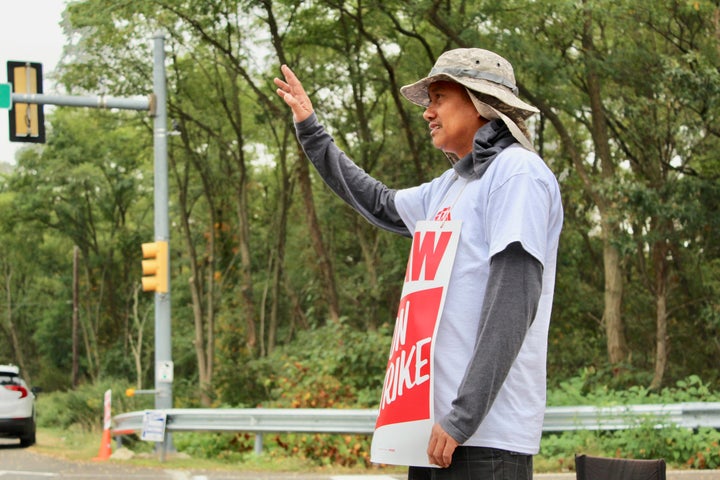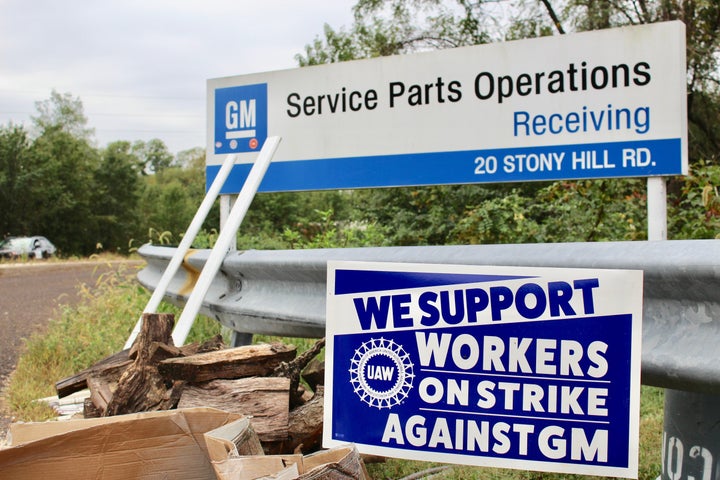LANGHORNE, Pa. ― After the sun went down Monday, Raina Shoemaker dropped four slices of cold pizza onto the grill grate and pushed them over the flame with a stick. When they were warm, she doled out the slices to her General Motors co-workers on makeshift plates fashioned from a torn pizza box.
Shoemaker, a GM warehouse worker, has been on strike for more than two weeks, much of that time spent in the glow of the fire outside the company’s parts distribution center here northeast of Philadelphia.
The GM employees, all members of the United Auto Workers union, were each assigned to a six-hour picket shift at the warehouse so that the protest could continue around the clock. While Shoemaker wasn’t officially on duty this particular night, there was nowhere else she’d rather have been.
“We are going to win this,” said Shoemaker, who’s worked at the warehouse for four years. “I don’t care what it takes. If I have to frigging support everyone, I will do it. Write that down. We are winning.”
The first prolonged U.S. auto strike in more than two decades entered its 17th day on Thursday, long enough to become dangerous for both sides. GM continues to lose money due to stalled production ― one estimate puts the cost at $1 billion so far ― while workers are starting to feel the squeeze of missed paydays.
The UAW started distributing strike pay to members on Monday, but $250 per week only goes so far in covering mortgages, groceries and truck payments. Those who could began saving months ago when a strike seemed possible, but many of the newer workers who are on a lower pay scale couldn’t afford to put money away. Every additional day the work stoppage lasts, the more those workers will be tested. Many, if not most, have never experienced a strike before.
The warehouse in Langhorne is a case study in how union members are holding it together now that GM has dug in and the burst of initial headlines has passed. The facility, which sends parts out to GM dealers along the East Coast, employs about 80 union members ― a tiny fraction of the nearly 50,000 on strike around the country. But they drew hundreds of supporters to a rally at the picket line over the weekend, a show of solidarity that stunned some strikers.
“This Has Brought Us Closer”
Food arrives at the Langhorne picket site every day ― bags of hoagies and boxes of doughnuts ― so much that the strikers can barely get through it all. The pizza came courtesy of some sympathetic steelworkers. Local members of the Democratic Socialists of America dropped off a load of wood to keep the fire burning. As Shoemaker reheated the pizza, a worker from a nearby Boeing plant showed up with another bundle of wood. He’s been stopping by ever since the strike started.
“The company had no idea how much support we would get,” said Charlie Correll, who’s 66 and has worked 48 years with GM. “And honestly, neither did we.”
Employees who passed by one another on shift changes for years with little more than a hi and bye, not even knowing names, are now camped out together, planning events and learning about each other’s families. Shoemaker said she decided to give her strike payment check to a co-worker who needs it more than she does.
“GM totally miscalculated,” said Dave Greenhalgh, who’s worked at GM facilities since the early 1980s. “This has brought us much closer. There were people who were on different shifts and didn’t know each other. Now they’re out here on the picket lines together.”
Workers went on strike to look out for one another, Greenhalgh said, and the divisions between workers inside GM have made for one of the most contentious issues in the negotiations.
“The company had no idea how much support we would get. And honestly, neither did we.”
- Charlie Correll
Although the contract talks are tight-lipped, GM probably wants to expand its use of temporary employees, a category the union believes has been exploited. Workers at the Langhorne facility say the use of temps has not been a major issue there, since most temps tend to get hired on within a few months. But they feel the problem is pervasive at assembly plants, where workers can remain “temporary” for two years or more and sometimes for multiple stints before becoming full-time employees.
Then there is the “in progression” system. In 2007, the UAW agreed to put newer hires on a lower pay scale as the company veered toward bankruptcy. The sacrifice helped keep GM alive, but it created rifts within plants and undermined a central tenet of unionism: equal pay for equal work. The union’s 2015 contract ultimately created a pathway for newer workers to reach the earning levels of legacy employees ― roughly $30 per hour ― but only after they’ve put in eight years. They start around $17 per hour.
Workers at the Langhorne facility said their system is even more complicated. According to Shoemaker and others, employees who came on after the 2015 contract top out closer to $24, because they work in distribution. They refer to one another as first-tier, second-tier and even third-tier, depending on when they started working for GM.
“It’s just not right,” said Correll, a legacy employee because of his long tenure. “They’re making over $10 billion a year [in profits]. Look at what the executives make. You want to cut costs? There’s your start.”

“They Wanted Animosity”
UAW members have made cutting down the amount of time it takes to reach the top rate a priority, as well as limiting the company’s use of temps ― both of which could go a long way toward healing divisions between tiers. Members worry that the persistence of a caste system could erode solidarity within the union over time, as different factions have less reason to support one another. After all, why would a newer hire look out for a legacy employee’s interests if he’s paid less for doing the same job?
Pat Sippos believes that was the idea all along. He is 60 and has spent 35 years with GM.
“They wanted animosity down the road,” Sippos said, standing by the bonfire. “They wanted us to be fighting each other.”
Sippos has made the top rate for years and earned a pension, for which newer hires aren’t eligible. But he supports the strike for reasons both philosophical and personal: His son is trying to build a career at the warehouse. Sippos is not worried about his own finances during the strike ― he can tap into his 401(k) without penalty at his age ― but he knows younger workers wouldn’t have the same cushion.
“That’s exactly why I’m still here and why I believe in the strike,” he said. “Anything that affects union brothers and sisters affects me ― and that’s the way people need to look at it.”
The Langhorne facility receives shipments of parts by truck, stocks them in the warehouse, and sends them back out to dealers. The operation relies on outside drivers to distribute the parts. The workers say that UPS drivers, who are Teamsters members, appear to have honored the picket line, cutting down how many shipments can leave the warehouse. FedEx drivers, they say, have continued to come and go.
The workers have maintained two pickets ― one at the quiet employee entrance, where Shoemaker was reheating pizza, and another at the busier truck entrance on the other side.
There have been rumors of scabs from New York working inside, but no one on the picket line knows for sure. Cars with dealer plates have been pulling in and out of the facility, likely GM dealers coming to pick up the parts that aren’t getting to them.
Whatever work is getting done inside probably comes at the hands of very tired managers. Every hour or so on a recent evening, a supervisor would pull out of the employee entrance and give the picketers a friendly honk and wordless wave before heading home. They would want the strike to end almost as much as their employees.
Like any company in the middle of a major work stoppage, GM is weighing the costs of lost production now against the future labor costs they’re resisting at the table. The company also is wondering when rank-and-file workers might start to waver as their bills mount. If the strike persists and workers feel increasingly squeezed, they may become more likely to accept a subpar deal just to get back to work.
The workers also worry about their health coverage. GM initially moved to cut off health insurance shortly after the strike started, which would force the union to dip into its strike fund to cover COBRA costs. After a round of bad press, the company reversed itself and said coverage would continue uninterrupted. But GM would not commit to maintaining it if the strike drags on.
Sippos has bladder cancer and a round of chemotherapy scheduled next week. He said if there’s any ambiguity regarding his health insurance, he would rather skip the chemo round than be handed a huge bill.

“A Few Weeks Of Sacrifice”
While a lot of news coverage has faded, many workers believe community support will become even more important as the strike wears on. The local UAW union is made up entirely of GM employees from the warehouse, and it no longer has its own union hall, instead renting a space for meetings.
Mindy Isser, a Philadelphia-based labor organizer, has been making the trip to Langhorne nearly every day after work, often with friends in tow, to boost morale. She helped raise about $3,000 online to put toward food and strike supplies. She and a friend recently took about a third of that money to BJ’s Wholesale Club to buy food for cash-strapped GM employees. Thirteen workers signed up their families to receive bags of groceries. The majority of them were second-tier employees.
On a recent morning, three strikers held the picket at the truck entrance, in a show of the workforce’s diversity: Kathy Henry, who is white; Jamel Johnson, who is African-American; and Joel Inocencio, a Filipino immigrant. They put down their strike signs briefly to wolf down some egg-and-cheese sandwiches a supporter had just dropped off. They waved whenever a car driving by gave a honk.
“I’m on the downside,” said Henry, who’s worked for GM for 35 years. She gestured to Johnson and Inocencio: “I’ve gotta stand out here on the concrete so these guys can have some job stability.”
Their last paycheck had come a week and a half earlier, and now it was the first of the month ― “bill time,” as Inocencio put it. He was starting to feel pinched financially. He planned on calling his mortgage lender later in the day to explain the strike and ask for leniency.
“But all of this ― it pays off, just hanging in there,” he said. “It’s a few weeks of sacrifice.”
A manager pulled up in her SUV and rolled down her window. Henry asked her if she missed them inside. The manager made a little heart with her hands.
“Do you miss us?” the manager asked in return.
“Of course we do,” Johnson said.
The manager told them to make sure they were wearing high-visibility vests at night and to stock up on firewood; colder weather is expected to move in within a few days.
“But hopefully this will all be over by then,” she said, before driving away.

